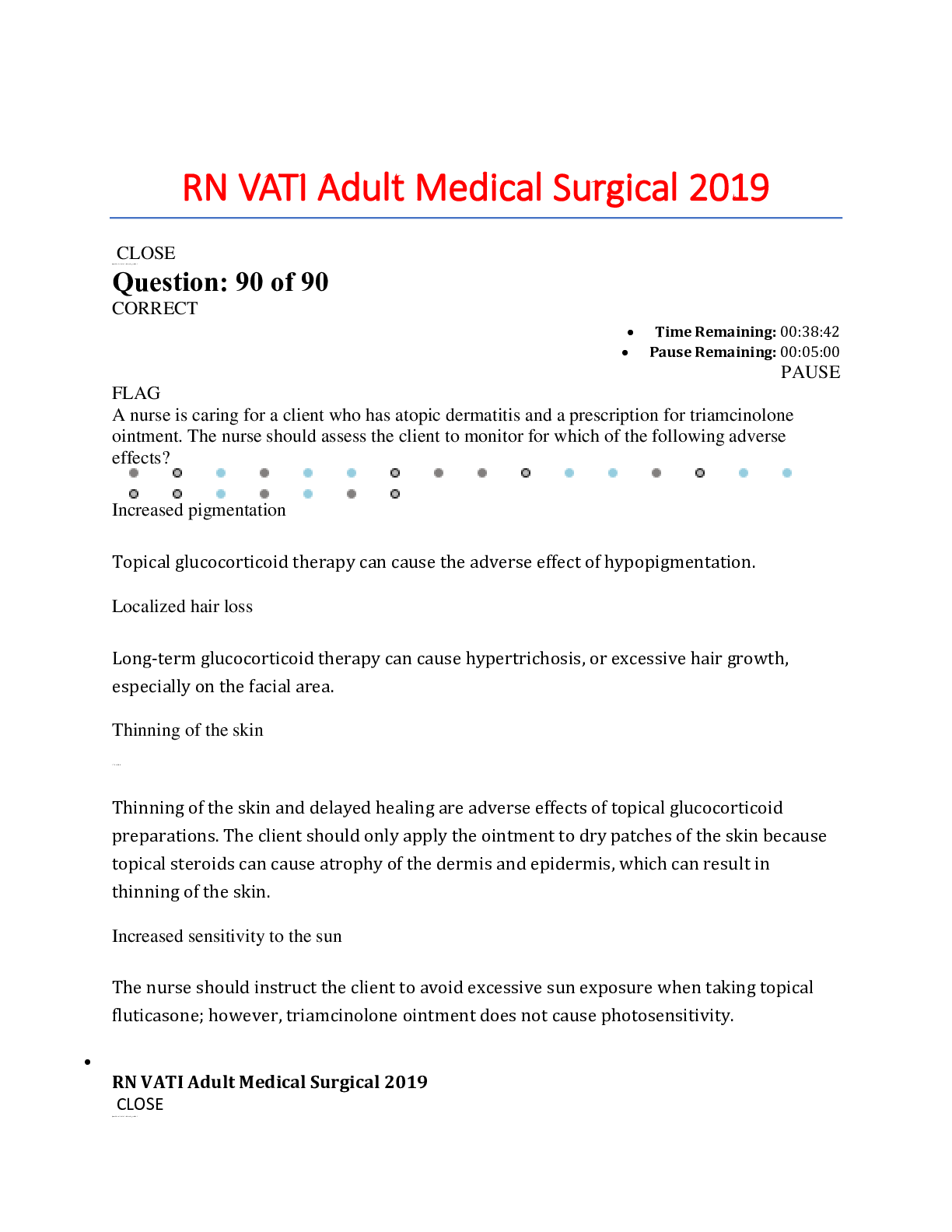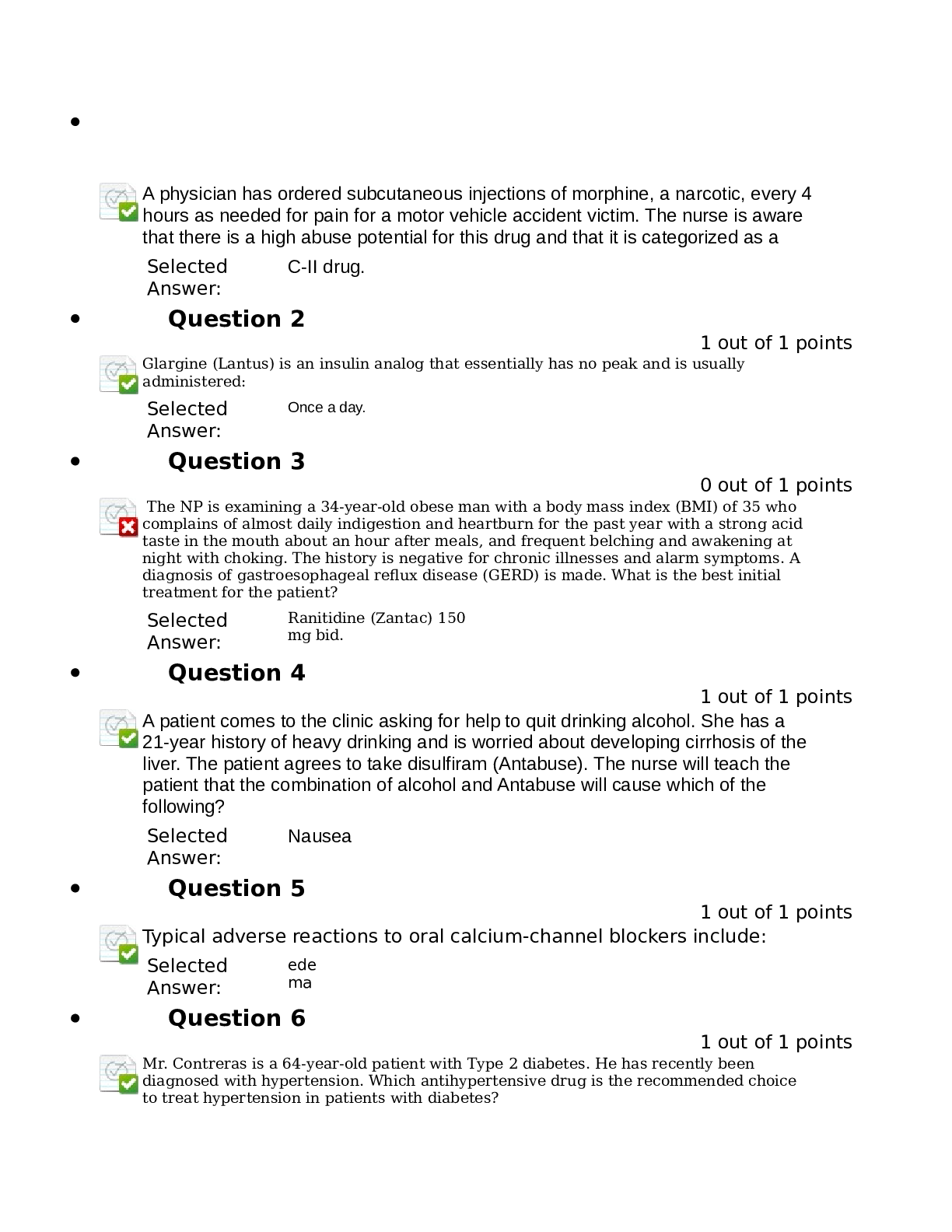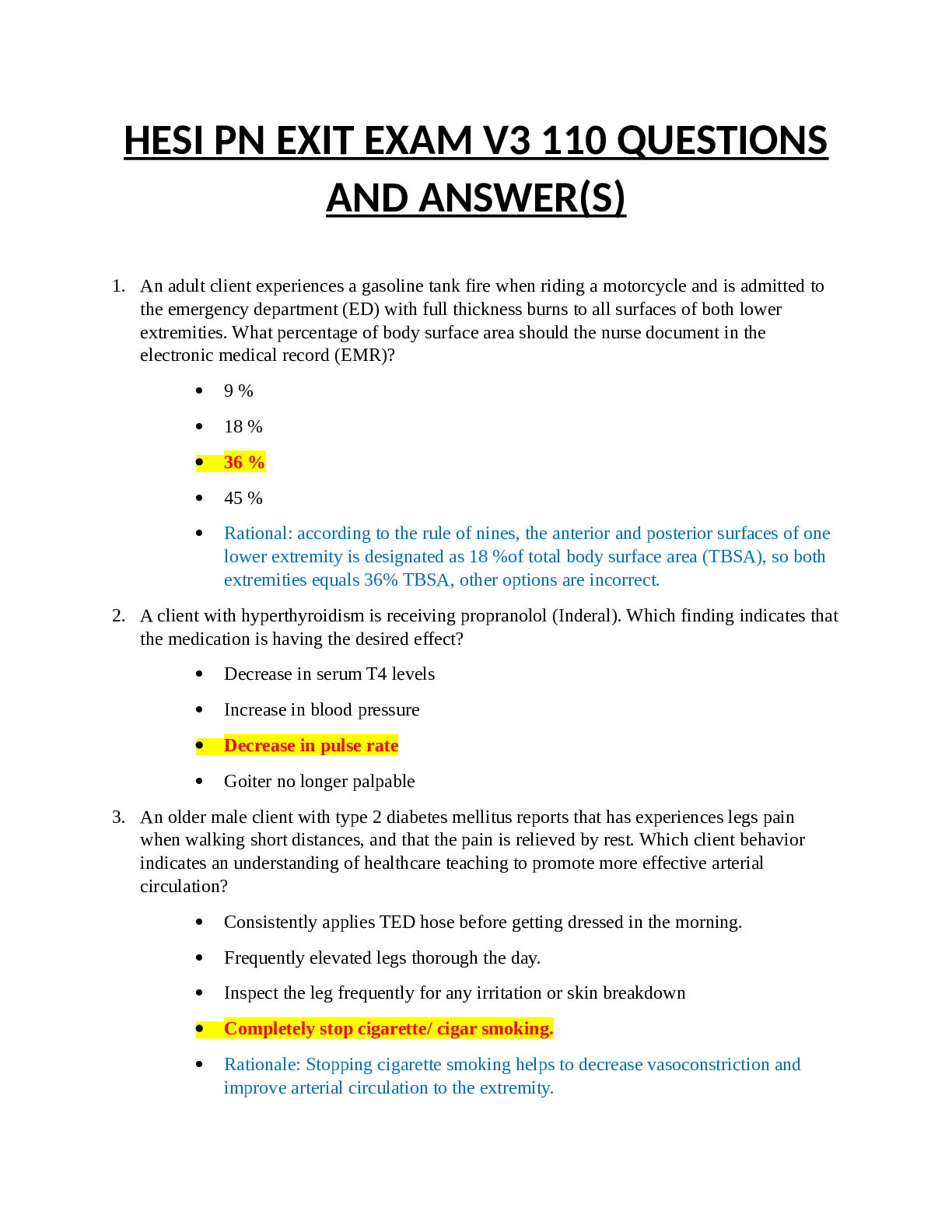*NURSING > QUESTIONS & ANSWERS > Detailed AnswerKey RN 46 C9 Pharmacology[with more than 110 questions and answers] graded A+]with ra (All)
Detailed AnswerKey RN 46 C9 Pharmacology[with more than 110 questions and answers] graded A+]with rationale
Document Content and Description Below
uria and acute kidney injury due to hemolysis; however, another action is the priority. B. Administer 0.9% sodium chloride through the IV line. Rationale: The client is at risk for hypotension and ... shock due to hemolysis, so it is important to keep an IV open to administer fluids and medications; however, another action is the priority. C. Stop the transfusion. Rationale: The greatest risk to the client is injury due to further hemolysis; therefore, the priority action is to stop the transfusion. When suspecting a hemolytic reaction, the priority action by the nurse is to immediately stop the transfusion to prevent further hemolysis. D. Notify the blood bank. Rationale: The client is at risk for hypotension and shock due to hemolysis, and the nurse must notify the blood bank to determine the cause of the hemolytic reaction; however, another action is the priority. 85.A nurse is preparing to administer phenytoin IV to a client who has a seizure disorder. Which of the following actions should the nurse plan to take? A. Administer the medication at 100 mg/min. Rationale: The nurse should administer phenytoin IV slowly, not faster than 50 mg/min, to reduce the risk of hypotension. B. Administer a saline solution after injection. Rationale: The nurse should flush the injection site with a saline solution after the injection of phenytoin to reduce and prevent venous irritation. C. Hold the injection if seizure activity is present. Rationale: The nurse should administer phenytoin to prevent and to abort seizure activity. D. Dilute the medication with dextrose 5% in water. Rationale: The nurse should dilute phenytoin in 0.9% sodium chloride solution to prevent precipitation of the medication. 86.A nurse is planning care for a client who has a detached retina and is preoperative for a surgical repair. The nurse should prepare to administer which of the following medications? A. Phenylephrine Rationale: Created on:08/29/2018 Page 40 Detailed Answer Key RN 46 C9 Pharmacology Mydriatic medications, such as phenylephrine, are used preoperatively to dilate pupils to facilitate intraocular surgery. B. Latanoprost Rationale:Latanoprost is a prostaglandin used for the treatment of glaucoma. C. Pilocarpine Rationale:Pilocarpine is a miotic medication used for the treatment of glaucoma. D. Timolol Rationale: Timolol is a beta-blocker used for the treatment of glaucoma. 87.A nurse is assessing a client who is receiving a parental lipid infusion. Which of the following findings is a manifestation of fat overload syndrome? A. Elevated temperature Rationale:An elevated temperature is an early manifestation of fat overload syndrome. The client is at risk for coagulopathy and multi-organ system failure due to fat overload syndrome. B. Hypertension Rationale: Hypertension is a manifestation of fluid overload. C. Peripheral edema Rationale:Peripheral edema is a manifestation of fluid overload. D. Erythema at the insertion site Rationale:Erythema at the insertion site is a manifestation of infection and can indicate the need to change infusion site. 88.A nurse is teaching a client who has a new prescription for aspirin to treat rheumatoid arthritis. The nurse should include to monitor for which of the following adverse effects of this medication? A. Constipation Rationale:Aspirin can cause diarrhea. B. Bleeding Rationale:Aspirin can cause bleeding, tinnitus, gastric ulceration, nausea, and heartburn. The client should monitor and report manifestations of bleeding, such as black tarry stools. C. Blurred vision Rationale:Aspirin can cause ototoxicity. Created on:08/29/2018 Page 41 Detailed Answer Key RN 46 C9 Pharmacology D. Insomnia Rationale:Aspirin can cause drowsiness. 89.A nurse is assessing an older adult client who is receiving digoxin. The nurse should recognize that which of the following findings is a manifestation of digoxin toxicity? A. Anorexia Rationale:Anorexia, vomiting, confusion, headache, and vision changes are manifestations of digoxin toxicity. B. Ataxia Rationale:Ataxia (lack of muscle coordination) is a manifestation of benzodiazepine toxicity. C. Photosensitivity Rationale: Digoxin toxicity causes halos around lights. Photosensitivity is a manifestation of NSAID toxicity. D. Jaundice Rationale: Jaundice is a manifestation of sulfonylurea toxicity. 90.A nurse is teaching a client who has a new prescription for colesevelam to lower his low-density lipoprotein level. Which of the following instructions should the nurse include? A. "Take this medication 4 hr after other medications." Rationale: The client should take this medication 4 hours after other medications to increase absorption of the medication. B. "Reduce fluid intake." Rationale: The client should increase fiber and fluid intake to reduce the risk for constipation. C. "Take this medication on an empty stomach." Rationale: The client should take the medication with meals. D. "Chew tablets before swallowing." Rationale: The client should swallow tablets whole to increase absorption. 91.A nurse is assessing a client who is receiving dopamine IV to treat left ventricular failure. Which of the following findings should indicate to the nurse that the medication is having a therapeutic effect? Created on:08/29/2018 Page 42 Detailed Answer Key RN 46 C9 Pharmacology A. Systolic blood pressure is increased Rationale: When dopamine has a therapeutic effect, it causes vasoconstriction peripherally and increases systolic blood pressure. B. Cardiac output is reduced Rationale:A therapeutic effect of low-dose dopamine is increased cardiac output. C. Apical heart rate is increased Rationale: Tachycardia is an adverse effect, not a therapeutic effect, of dopamine. D. Urine output is reduced Rationale:A therapeutic effect of low-dose dopamine is increased urine output. Decreased urine output at high doses is an adverse effect of dopamine. 92.A nurse is teaching a client who has a new prescription for sucralfate to treat a gastric ulcer. Which of the following statements by the client indicates an understanding of the teaching? A. "I will take this medication as needed to reduce pain." Rationale: The client should take sucralfate on 4 times a day for 4 to 8 weeks to promote ulcer healing. B. "I will reduce my fluid intake with this medication." Rationale: The client should increase his fluid and fiber intake to prevent constipation. C. "I will take this medication with an antacid." Rationale: The client should wait 30 min between sucralfate and an antacid to increase absorption. D. "I will take this medication 1 hour before meals and at bedtime." Rationale: The client should take sucralfate on an empty stomach, 1 hr before each meal and at bedtime to create a protective coating over the ulcer. 93.A nurse is teaching a client who has diabetes mellitus and receives 25 units of NPH insulin every morning if her blood glucose level is above 200 mg/dL. Which of the following information should the nurse include? A. Discard the NPH solution if it appears cloudy. Rationale: The client should discard regular insulin if it appears cloudy. B. Shake the insulin vigorously before loading the syringe. Rationale: The client should gently roll the NPH insulin before loading the syringe to disperse the mixture without creating bubbles. C. Expect the NPH insulin to peak in 6 to 14 hr. Rationale: Created on:08/29/2018 Page 43 Detailed Answer Key RN 46 C9 Pharmacology NPH insulin is an intermediate-acting insulin. Its onset of action is 1 to 2 hr, peaking at 6 to 14 hr. Its duration of action is 16 to 24 hr. The client is at risk for hypoglycemia during the peak time. D. Freeze unopened insulin vials. Rationale: The unopened insulin vials should be stored in the refrigerator. 94.A nurse is assessing a client who is receiving a unit of packed RBCs. The client appears flushed and reports low-back pain. Which of the following actions is the nurse's priority? A. Stop the transfusion. Rationale: The greatest risk to the client is injury due to further hemolysis; therefore, the priority action is to stop the transfusion. When a hemolytic reaction is suspected, the priority action by the nurse is to immediately stop the transfusion to prevent further hemolysis. B. Collect a urine specimen. Rationale: The client is at risk for hemoglobinuria and acute kidney injury due to hemolysis, so a urine specimen is required; however, another action is the priority. C. Notify the blood bank. Rationale: The client is at risk for hypotension and shock due to hemolysis, and the nurse must notify the blood bank to determine the cause of the hemolytic reaction; however, another action is the priority. D. Begin an infusion of 0.9% sodium chloride through new tubing. Rationale: The client is at risk for hypotension and shock due to hemolysis, so it is important to keep an IV open to administer fluids and medications; however, another action is the priority. 95.A nurse is teaching a client who has a new prescription for fluoxetine to treat depression. Which of the following statements by the client indicates an understanding of the teaching? A. "I should expect to feel better after 24 hours of starting this medication." Rationale: The therapeutic effects of this medication can take 1 to 4 weeks to occur. B. "I should not take this medicine with grapefruit juice." Rationale: Grapefruit juice can interfere with the metabolism of lovastatin, but it does not affect fluoxetine. C. "I'll take this medicine with food." Rationale: The client can take fluoxetine with or without food. D. "I'll take this medicine first thing in the morning." Rationale: The client should take fluoxetine in the morning to reduce the risk for insomnia. Created on:08/29/2018 Page 44 Detailed Answer Key RN 46 C9 Pharmacology 96.A nurse is teaching a client who has a new prescription for docusate. Which of the following information should the nurse include in the teaching? A. "Do not take this medication before bedtime." Rationale: The client can take this medication in the morning or in the evening before bedtime. B. "Take the medication with a full glass of water." Rationale: The nurse should instruct the client to take this medication with a full glass of water, unless contraindicated, to reduce the risk for constipation. C. "Expect abdominal pain with this medication." Rationale: The client should notify the provider if abdominal pain occurs. D. "Take this medication on an empty stomach." Rationale: The client can take this medication with or without food. 97.A nurse is instructing the parents of a client who has a new prescription for methylphenidate. Which of the following instructions should the nurse include? A. Avoid activities that require alertness such as driving. Rationale: The client should avoid driving and other activities that require alertness until the effects of this medication are known. B. Increase caffeine intake. Rationale: The client should decrease caffeine intake to reduce the risk for excessive stimulation and irritability. C. Take this medication before bedtime. Rationale: The client should take this medication 6 hr before sleep to reduce the risk for insomnia. D. Reduce calorie intake. Rationale: This medication can cause anorexia and weight loss. 98.A nurse is teaching a client who has a new prescription for aluminum hydroxide to treat heartburn. The nurse should instruct the client to monitor for and report which of the following adverse reactions? A. Constipation Rationale:Aluminum hydroxide can cause constipation. The nurse should tell the client to increase fluid and fiber intake to reduce the risk for constipation. Created on:08/29/2018 Page 45 Detailed Answer Key RN 46 C9 Pharmacology B. Flatulence Rationale: Calcium-containing antacids can cause flatulence. C. Palpitations Rationale: Cimetidine can cause dysrhythmias. D. Headache Rationale:Proton pump inhibitors can cause headaches. 99.A nurse is preparing to administer heparin to a client. Which of the following actions should the nurse plan to take? A. Use a 22-gauge needle to inject the medication. Rationale: The nurse should use a small needle, 25- or 26-gauge, to administer the heparin. B. Use a 1-inch needle to inject the medication. Rationale: The nurse should use a short needle, 3/8 inch or smaller, to administer the heparin. C. Inject the medication into the abdomen above the level of the iliac crest. Rationale: The nurse should inject the medication into the abdomen above the level of the iliac crest, at least 2 inches from the umbilicus. D. Massage the injection site after administration of the medication. Rationale: The nurse should apply firm pressure without massage to the site for 1 to 2 min after administration. Massaging the area after injecting heparin can cause bleeding. 100.A nurse is teaching a client how to draw up regular insulin and NPH insulin into the same syringe. Which of the following instructions should the nurse include? A. Draw up the NPH insulin into the syringe first. Rationale: The nurse should teach the client to draw up the regular insulin into the syringe first. B. Inject air into the regular insulin first. Rationale: The nurse should teach the client to inject air into the NPH vial first. C. Shake the NPH insulin until it is well mixed. Rationale: The nurse should teach the client to roll the vial of NPH insulin between the palms of his hands, not to shake it, to prevent forming bubbles, which can cause inaccurate dosage. D. Discard regular insulin that appears cloudy. Rationale: The nurse should teach the client to discard any regular insulin that appears cloudy, as Created on:08/29/2018 Page 46 Detailed Answer Key RN 46 C9 Pharmacology regular insulin should be clear. NPH insulin has a cloudy appearance. 101.A nurse is assessing a client who is on long term omeprazole therapy. Which of the following findings should indicate to the nurse the medication is effective? A. Increased appetite Rationale: Omeprazole does not increase appetite. Nausea is an adverse effect of this medication. B. Regular bowel movements Rationale: Omeprazole does not produce regular bowel movements. Diarrhea is an adverse effect of this medication. C. Absence of headache Rationale: Omeprazole does not treat headaches. Headaches are an adverse effect of this medication. D. Reduced dyspepsia Rationale: Omeprazole, a proton pump inhibitor, reduces gastric acid secretion and treats duodenal and gastric ulcers, prolonged dyspepsia, gastrointestinal reflux disease, and erosive esophagitis. 102.A nurse is teaching a client who has a new prescription for disulfiram. Which of the following information should the nurse include in the teaching? A. "Avoid grapefruit juice while taking this medication." Rationale: Grapefruit juice can reduce the metabolism of carbamazepine. B. "Do not crush this medication before swallowing." Rationale: The client can crush disulfiram before swallowing. C. "Do not drink alcohol while taking this medication." Rationale: Disulfiram is a type of aversion therapy that helps maintain abstinence from alcohol. Drinking alcohol while taking disulfiram can produce a life-threatening response that can include palpitations, headache, and hypotension. Therapy must not begin until the client has abstained from alcohol for at least 12 hr. The client should avoid all forms of alcohol including cough syrups and after-shave lotions. D. "Take this medication with food." Rationale: Disulfiram is taken with or without food. 103.A nurse is reviewing the medication list for a client who has a new diagnosis of type 2 diabetes mellitus. The nurse should recognize which of the following medications can cause glucose intolerance? Created on:08/29/2018 Page 47 Detailed Answer Key RN 46 C9 Pharmacology A. Ranitidine Rationale: Ranitidine can alter serum creatinine levels, but it does not affect blood glucose levels. B. Guaifenesin Rationale: Guaifenesin can cause drowsiness and dizziness, but does not alter blood glucose. C. Prednisone Rationale: Corticosteroids such as prednisone can cause glucose intolerance and hyperglycemia. The client might require increased dosage of a hypoglycemic medication. D. Atorvastatin Rationale:Atorvastatin can interfere with thyroid function tests. 104.A nurse in the emergency department is caring for a client who took 3 nitroglycerin tablets sublingually for chest pain. The client reports relief from the chest pain but now he is experiencing a headache. Which of the following statements should the nurse make? A. "A headache is an indication of an allergy to the medication." Rationale:Allergic reactions typically manifest as itching and a rash, and if worsening, laryngeal edema and bronchospasm. B. "A headache is an expected adverse effect of the medication." Rationale: The vasodilation nitroglycerin induces increases blood flow to the head and typically results in a headache. C. "A headache indicates tolerance to the medication." Rationale: With tolerance, the client needs more of the medication to achieve a therapeutic response. A headache is not a sign of this phenomenon. D. "A headache is likely due to the anxiety about the chest pain." Rationale: This is a nontherapeutic communication technique and offers the nurse's opinion about the cause of the headache rather than a factual statement. 105.A nurse is teaching a client who has a new prescription for transdermal nitroglycerin to treat angina pectoris. Which of the following instructions should the nurse include in the teaching? A. Apply a new transdermal patch once a week. Rationale: The client should apply a new patch each day, not once a week. B. Apply the transdermal patch in the morning. Rationale: The client should apply the patch every morning and leave it in place for a 12 to 14 hr, then Created on:08/29/2018 Page 48 Detailed Answer Key RN 46 C9 Pharmacology remove it in the evening. C. Apply the transdermal patch in the same location as the previous patch. Rationale: The client should rotate the sites used for patch placement to avoid areas of local skin irritation. D. Apply a new transdermal patch when chest pain is experienced. Rationale: The transdermal route of nitroglycerin has a delayed onset of action, making it suitable for prophylaxis use but not for immediate relief of chest pain. 106.A nurse is preparing to transfuse one unit of packed RBC to a client who experienced a mild allergic reaction during a previous transfusion. The nurse should administer diphenhydramine prior to the transfusion for which of the following allergic responses? A. Urticaria Rationale: For clients who have previously had allergic reactions to blood transfusions, administering an antihistamine such as diphenhydramine prior to the transfusion might prevent future reactions. Allergic reactions typically include urticaria (hives). B. Fever Rationale:An antihistamine will not prevent a febrile, non-hemolytic reaction to a blood transfusion. A possible preventive measure is transfusing leucocyte-poor blood products to avoid sensitization to the donor's WBC. C. Fluid overload Rationale:An antihistamine will not prevent fluid overload. Transfusing the blood product slowly and not exceeding the volume that is necessary can reduce this risk. D. Hemolysis Rationale:An antihistamine will not prevent hemolysis, which results from incompatibility between the donor and the recipient. 107.A nurse is preparing to administer nalbuphine to a postoperative client who is experiencing pain. The nurse should monitor the client for which of the following potential adverse effects of this medication? A. Miosis Rationale:Adverse effects of nalbuphine include visual disturbances such as miosis, blurred vision, and diplopia. B. Joint pain Rationale: Nalbuphine is unlikely to cause joint pain; however, it can cause headache and abdominal cramps. Created on:08/29/2018 Page 49 Detailed Answer Key RN 46 C9 Pharmacology C. Diarrhea Rationale: Nalbuphine can cause constipation, cramps, and abdominal pain, but it does not have diarrhea as an adverse effect. D. Oliguria Rationale: Nalbuphine is unlikely to cause oliguria; however, it can cause urinary urgency. 108.A nurse is caring for a client who is postoperative following a transurethral resection of the prostate (TURP). The nurse should plan to administer the client's PRN bethanechol when the client reports which of the following manifestations? A. Bladder spasms Rationale:Antispasmodic medications, not bethanechol, help control bladder spasms after a TURP. B. Severe pain. Rationale:Analgesic medications, not bethanechol, help relieve severe pain after a TURP. C. An inability to void Rationale:Bethanechol is a cholinergic medication that stimulates the parasympathetic nervous system, thus improving the tone and motility of the smooth muscles of the urinary tract enough to initiate urination. D. Frequent episodes of painful urination Rationale:Analgesic medications, or antibiotics if infection is the cause, help relieve frequent episodes of painful urination after a TURP. 109.A nurse is teaching a client who has a duodenal ulcer about his new prescription for cimetidine. The nurse should include which of the following instructions in the teaching? A. "Take the medication with an antacid to minimize stomach upset." Rationale: Clients should not take this medication within 1 hr of taking an antacid because the antacid will interfere with the absorption of cimetidine. B. "Your doctor might need to reduce your theophylline dose while taking this medication." Rationale: The nurse should instruct the client that the provider might need to reduce his theophylline dose due to the possibility of increased medication levels. C. "Take the medication on an empty stomach for better absorption." Rationale: Clients should take cimetidine with food to minimize gastric irritation. D. "You should plan to take this medication for at least 6 months." Rationale: Created on:08/29/2018 Page 50 Detailed Answer Key RN 46 C9 Pharmacology The nurse should instruct the client that he should plan to take cimetidine for short-term treatment of a duodenal ulcer, which will be approximately 4 to 6 weeks. 110.A nurse is reviewing the laboratory results of a client who has liver failure with ascites and is receiving spironolactone. Which of the following findings should the nurse expect? A. Decreased sodium level Rationale: The nurse should expect a decreased sodium level. Spironolactone is a potassium-sparing diuretic that inhibits the action of aldosterone, resulting in an increased excretion of sodium. B. Decreased phosphate level Rationale: The nurse should not expect a decreased phosphate level. Spironolactone inhibits the action of aldosterone, resulting in the retention of phosphate. C. Decreased potassium level Rationale: The nurse should not expect a decreased potassium level. Spironolactone is a potassium-sparing diuretic that inhibits the action of aldosterone, resulting in the retention of potassium. D. Decreased chloride level Rationale: The nurse should not expect a decreased chloride level. Spironolactone is a potassium-sparing diuretic that inhibits the action of aldosterone, resulting in the retention of chloride. 111.A nurse is assessing a client who has systemic lupus erythematosus and is taking hydroxychloroquine. The nurse should report which of the following adverse effects to the provider immediately? A. Diarrhea Rationale: Diarrhea is a potential adverse effect of hydroxychloroquine that the nurse should report to the provider; however, it is not the priority finding. B. Blurred vision Rationale: When using the urgent vs non-urgent approach to client care, the nurse should determine that the priority finding to report to the provider is blurred vision, as this is a manifestation of hydroxychloroquine toxicity and can be an indication of retinal damage. C. Pruritus Rationale:Pruritus is a potential adverse effect of hydroxychloroquine that the nurse should report to the provider; however, it is not the priority finding. D. Fatigue Rationale: Fatigue is a potential adverse effect of hydroxychloroquine that the nurse should report to the provider; however, it is not the priority finding. Created on:08/29/2018 Page 51 Detailed Answer Key RN 46 C9 Pharmacology 112.A nurse is caring for a client who has thrombophlebitis and is receiving a continuous heparin infusion. Which of the following medications should the nurse have available to reverse heparin's effects? A. Vitamin K Rationale:Vitamin K reverses the effects of warfarin, not heparin, by promoting the synthesis of coagulation factors VI, IX, X, and prothrombin. B. Protamine sulfate Rationale:Protamine sulfate reverses the effects of heparin by binding with heparin to form a heparin-protamine complex that has no anticoagulant properties. C. Acetylcysteine Rationale:Acetylcysteine, a mucolytic, reduces the risk of hepatotoxicity after acetaminophen overdose. It does not reverse the effects of heparin toxicity. D. Deferasirox Rationale:A chelating agent such as deferasirox binds to iron to reduce iron toxicity from supplemental iron therapy. It does not reverse the effects of heparin toxicity. 113.A nurse is caring for a client who has heart failure and is receiving IV furosemide. The nurse should monitor the client for which of the following electrolyte imbalances? A. Hypernatremia Rationale: The nurse should monitor the client who is receiving IV furosemide for hyponatremia. B. Hyperuricemia Rationale: The nurse should monitor the client who is receiving IV furosemide for hyperuricemia. The nurse should instruct the client to notify the provider for any tenderness or swelling of the joints. C. Hypercalcemia Rationale: The nurse should monitor the client who is receiving IV furosemide for hypocalcemia. D. Hyperchloremia Rationale: The nurse should monitor the client who is receiving IV furosemide for hypochloremia. 114.A nurse is teaching a client who has multiple sclerosis about a new prescription for baclofen. Which of the following instructions should the nurse include in the teaching? A. "Do not take antihistamines with this medication." Rationale: Created on:08/29/2018 Page 52 Detailed Answer Key RN 46 C9 Pharmacology The nurse should instruct the client not to take antihistamines while taking baclofen. Antihistamines will intensity the depressant effects of baclofen. B. "Take the medication on an empty stomach." Rationale: The medication causes nausea and gastrointestinal distress, so the client should take it with milk or meals. C. "Stop taking the medication immediately for a headache." Rationale:Abrupt withdrawal of baclofen, a centrally acting muscle relaxant, might cause seizures, fever, and hypotension. A better alternative is to treat the headache, which can have many other causes, and see if it resolves as medication therapy with baclofen continues. D. "Expect to develop diarrhea initially." Rationale:Baclofen is more likely to cause constipation than diarrhea. 115.A nurse is teaching a client who has a new prescription for diazepam. Which of the following information should the nurse include in the teaching? A. Diazepam can cause drowsiness. Rationale: Diazepam has sedative properties, so the client should not engage in potentially hazardous activities after receiving diazepam. B. This medication must be swallowed whole. Rationale: Diazepam can be crushed and taken with food if the client is unable to swallow the medication whole. C. It is important to avoid foods that contain tyramine. Rationale: Clients who take monoamine oxidase inhibitors must avoid foods that contain tyramine. D. Grapefruit juice inactivates this medication. Rationale:Although grapefruit juice can affect the metabolism of many medications, generally raising their blood levels, diazepam is not among them. 116.A nurse is reviewing discharge instructions with a client who has rheumatoid arthritis and a new prescription for prednisone. Which of the following statements by the client indicates an understanding of the teaching? A. "I should take my flu vaccine within one week of starting this medication." Rationale: The nurse should instruct the client to avoid taking vaccines while taking prednisone. This medication can decrease antibody response to the vaccine and can increase the risk of infection from live virus vaccines. B. "I can expect a sore throat for the first week after starting this medication." [Show More]
Last updated: 1 year ago
Preview 1 out of 54 pages
Instant download
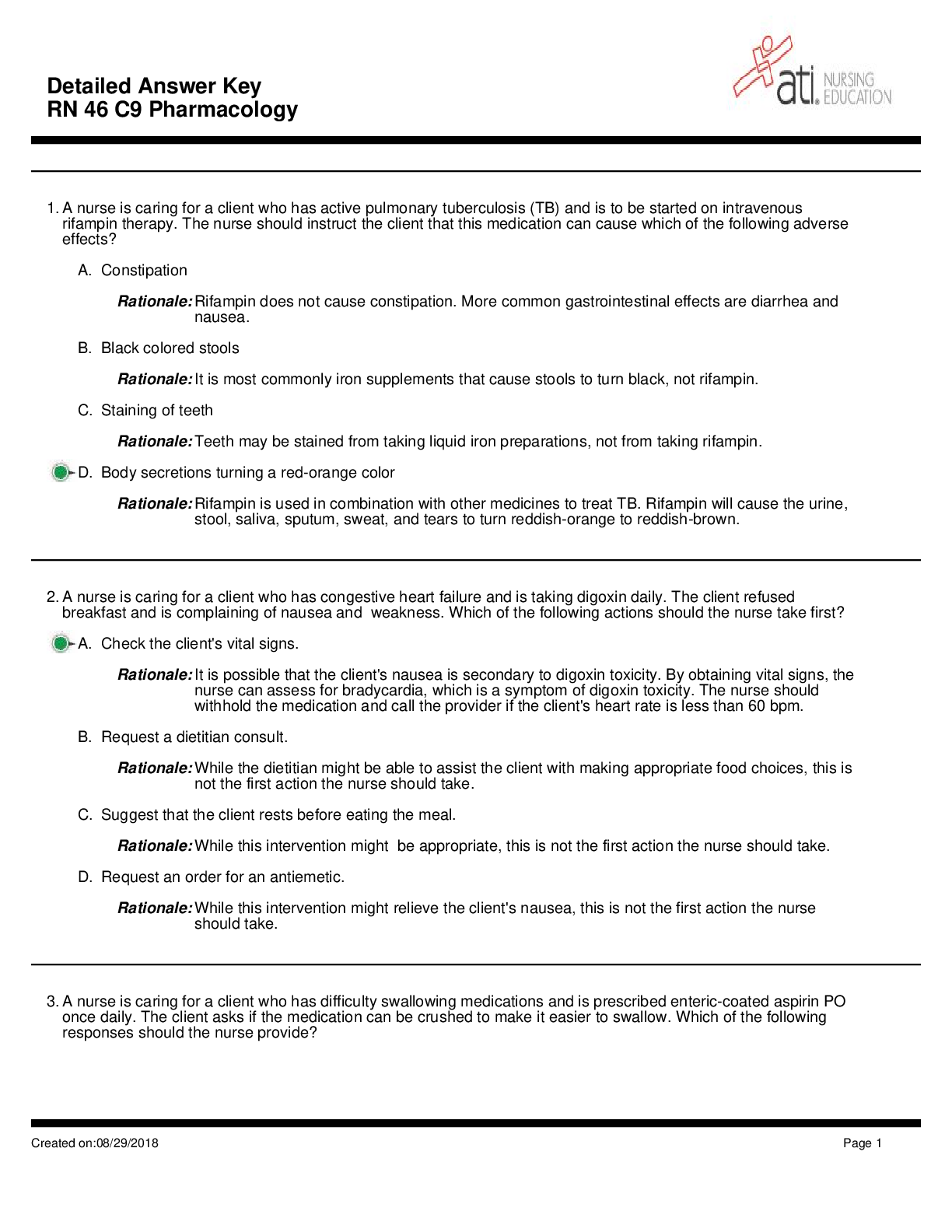
Buy this document to get the full access instantly
Instant Download Access after purchase
Add to cartInstant download
Reviews( 0 )
Document information
Connected school, study & course
About the document
Uploaded On
May 03, 2021
Number of pages
54
Written in
Additional information
This document has been written for:
Uploaded
May 03, 2021
Downloads
0
Views
19

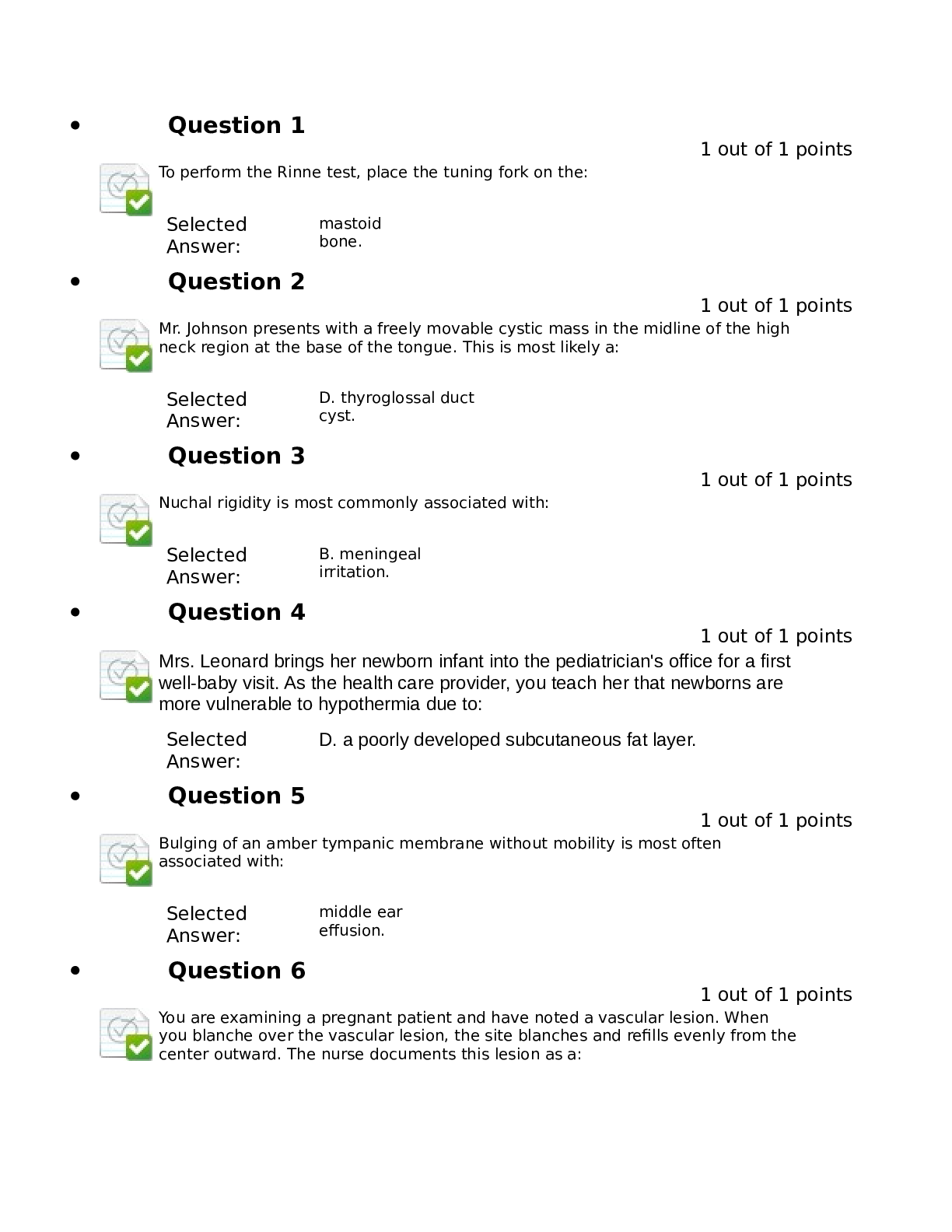
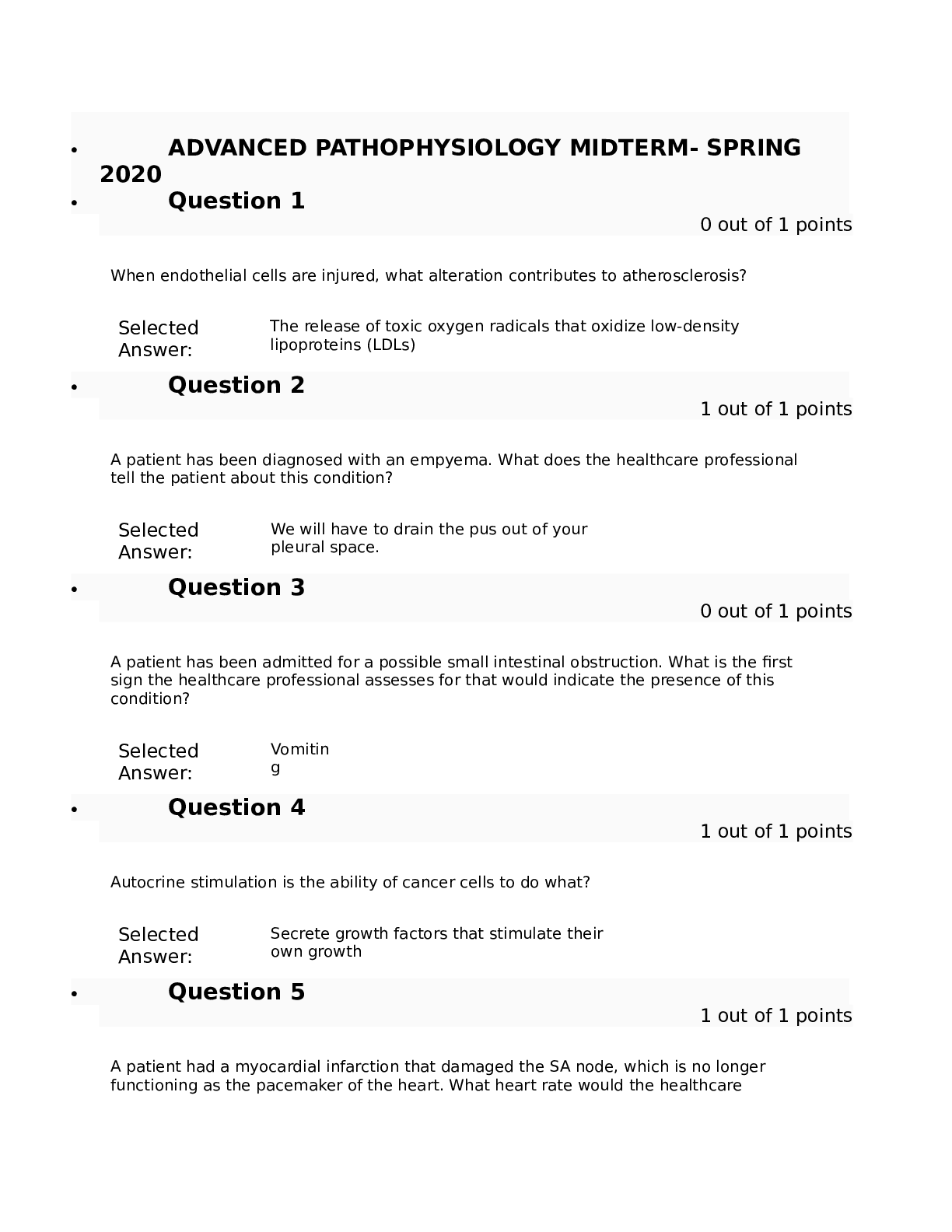
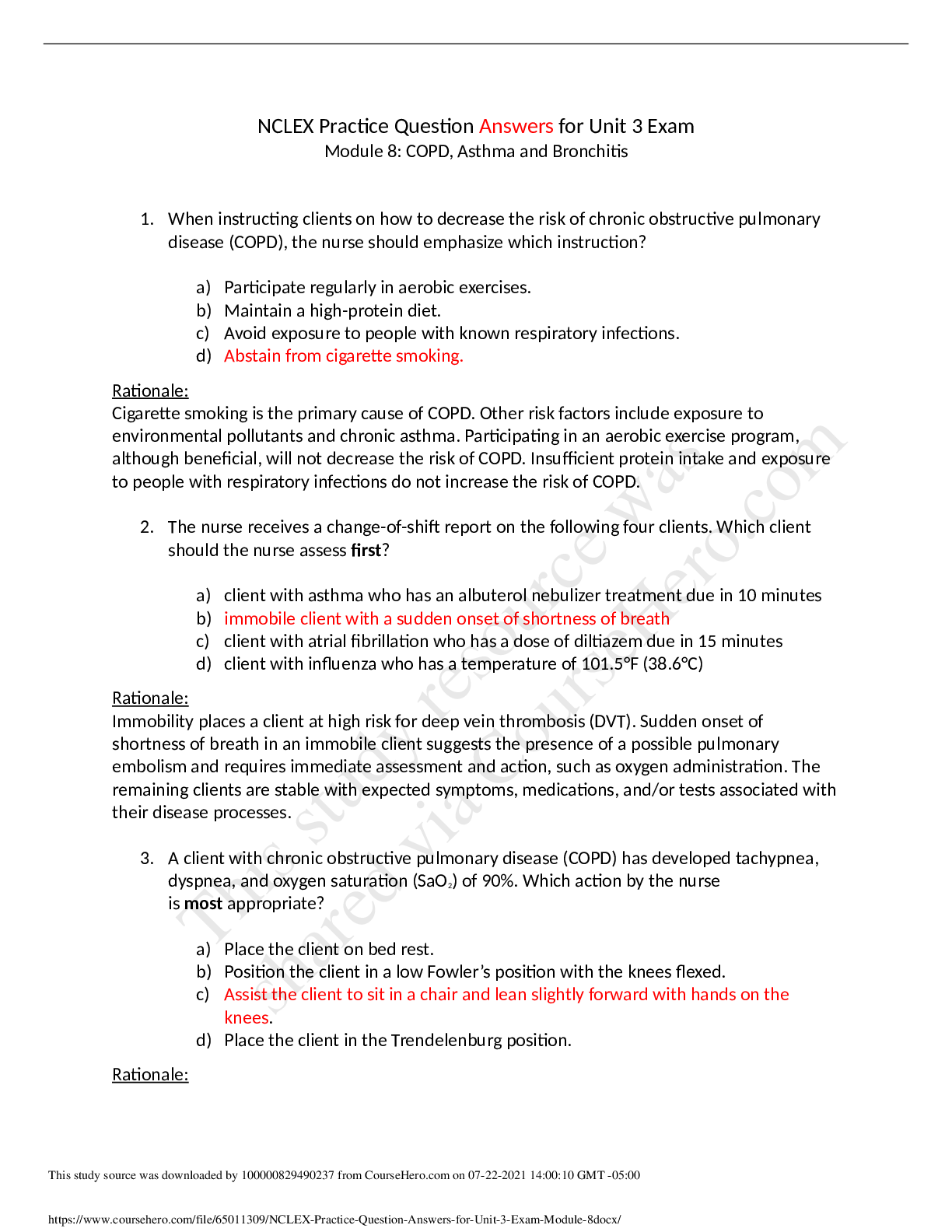
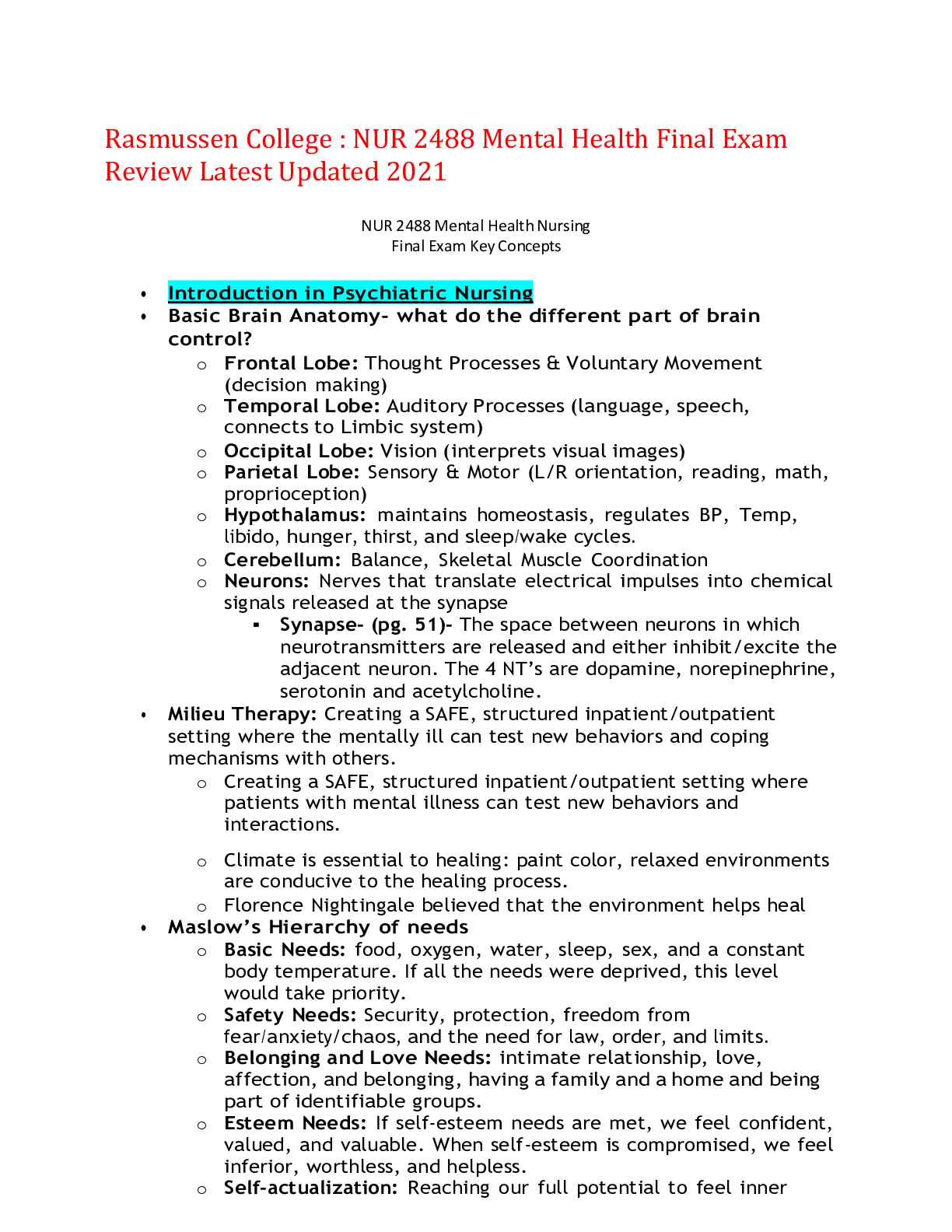
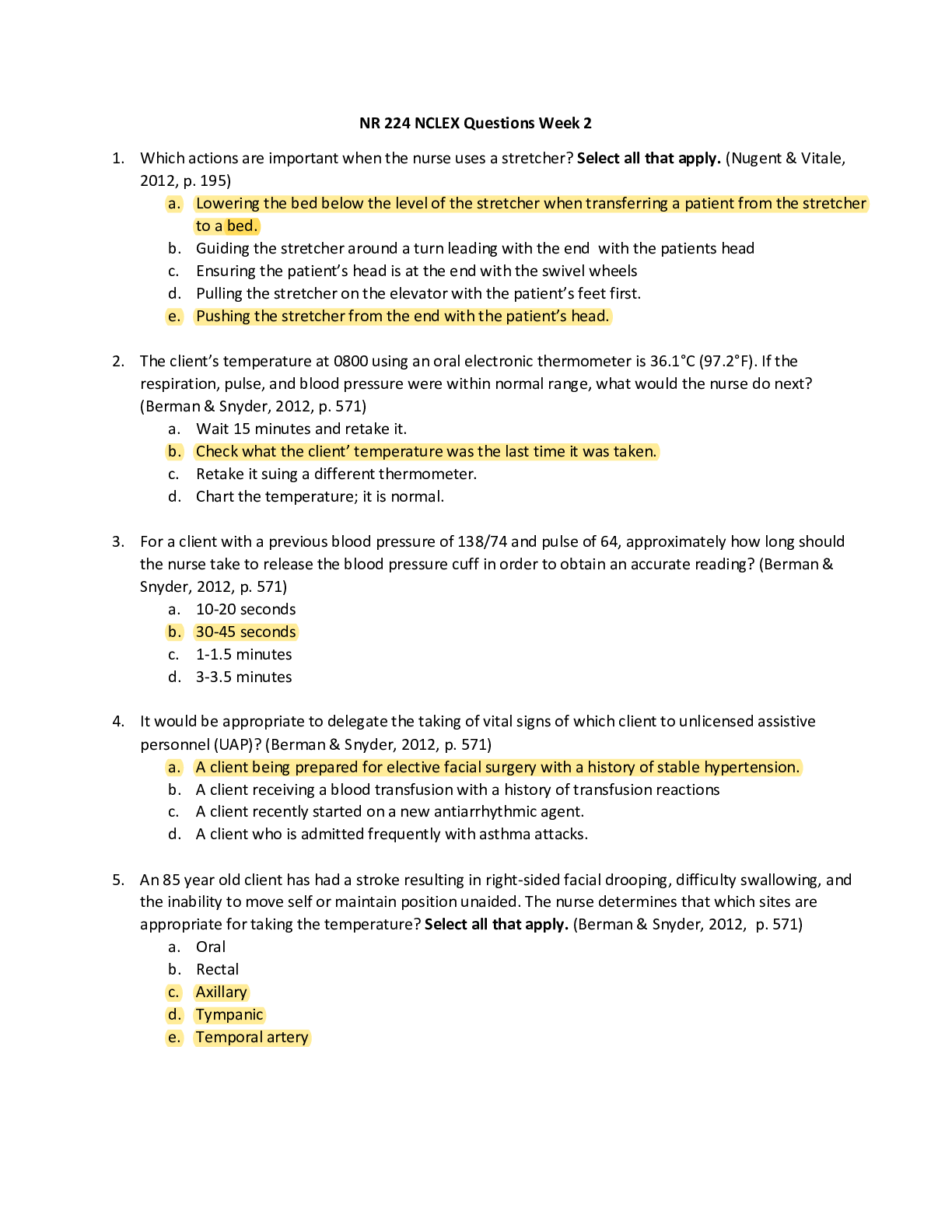
.png)
.png)
.png)

